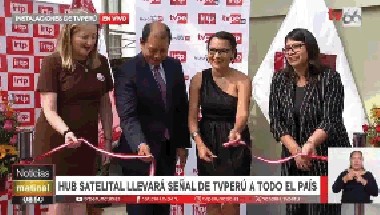CASE STUDY: Providing Ubiquitous Acess to Free-to-Air Public TV Channels in Peru
Lima, Peru, April 12, 2024 - The South American country of Peru is home to 34.5 million people. It’s a country of diverse geography, featuring coastal deserts, rainforests and mountain ranges. Around a third of Peru’s population have settled along the desert coastal belt and around the capital city of Lima, and roughly half live in the Andean highlands. The remainder live on the slopes of the Andes and rainforest, though this is sparsely populated. Approximately 30% of the population in Peru live below the poverty line and, according to the World Bank, 21% live in rural areas, where poverty rates are higher and terrestrial connectivity is limited.
 |
Many in Peru lack access to basic information technology such as internet access. Living in a country with high rates of poverty, for many, connectivity is an unaffordable luxury. This means that many Peruvians are unable to access educational, governmental, and healthcare resources. This results in a plethora of lost life opportunities for many people in Peru, especially in rural areas. The Digital Divide was exacerbated by the COVID pandemic, which exposed the lack of connectivity to poor and remote communities when access to digital services like public broadcasting and e-learning was so important. This lack of connectivity had a direct impact on the amount of deaths as the health messages around COVID-19 were not getting through to indigenous communities. Peru lost more lives through COVID than any other country per capita.
Challenges
During the global COVID-19 pandemic, the National Institute of Radio and Television of Peru (IRTP) quickly realized they were incapable of:
- Effectively communicating critical public health news and information via public broadcasting,
- Providing a viable Distance Learning platform to the nearly 30% of the Peruvian population without connectivity.
A solution was needed to address these gaps in connectivity infrastructure that included both video and non-video data.
Solution
The National Institute of Radio and Television of Peru (IRTP) selected SKYflow, a partner ecosystem whose technology leverages the DVB-NIP (Native IP) standard and does not require internet connectivity. The cutting-edge multicast ABR (Adaptive Bit Rate) ecosystem offers cost-effective, ultra-fast, low-latency delivery of live video, files and documents to mobile devices and large screens for global audiences.
Because of SKYflow, the final 30% of the Peruvian population will receive Direct-to-Home (DTH) content and have access to live TV that can be recorded, enabling the Peruvian government to attain its goal of reaching every household in Peru with invaluable educational video and media content. This is especially significant for the distribution of content in a multiscreen environment to households that may not have internet access but have a television, tablets, or even smart devices. SKYflow is also capable of providing two-way broadcasting which would expand the use cases available to the Peruvian government in the future, allowing it to benefit from the unique attributes that satellite brings to the delivery of OTT services.
A multi-phased implementation, live video, including public broadcasting, will be provided at launch early 2024. File-based delivery, including content from the Peruvian Ministry of Education to support distance learning, will follow in 2024. The project is being co-managed as a system integration by DIVICAM and ST Engineering iDirect.
Results
 |
|
| The launch of the new platform utilizing the SKYflow solution enabled everyone in Peru to access free-to-air public TV channels 24 x 7 |
The launch of the new platform utilizing the SKYflow ecosystem made national news on January 17, 2024- the 66th anniversary of IRTP, marking a watershed moment in the history of Peruvian broadcasting. Now every individual in Peru will have access to view entertainment and educational content, 24 hours a day – free of charge. Regional and municipal governments are making self-install kits available so that households can implement the system at home.
The project was a year in development with IRTP and the SKYflow partners working to assist the Government of Peru to reach 100% of the population with cost-effective, ultra-fast, low-latency delivery of DTH live and file-based video content to homes and mobile devices. The ecosystem partners are working to supplement this offering with multiple government and educational channels, emergency/disaster notifications, the option of 2-way network communications, all-IP contribution capabilities, and more. The project is being co-managed as a system integration by DIVICAM and ST Engineering iDirect. Leading satellite operator Eutelsat Group has been chosen to deliver satellite capacity for content distribution to the unconnected population of Peru. Underscoring Eutelsat’s dedication to supporting digital inclusion programs initiated by public authorities in emerging countries. This breakthrough represents more than content delivery for all. It is transformational for Peruvians who have previously lived without any consistent access to content and information. It opens doors to education, business opportunities, healthcare and even life-saving information. Now, not one household needs to go without this invaluable information source and with the very real prospect of two-way communication through SKYflow in the near future, the possibilities are endless.
“Following a year of development by teams at ST Engineering iDirect and partners EKT, Quadrille and EasyBroadcast, we’re pleased to confirm the activation of live free-to-air channels in Peru using SKYflow – a DVB Native IP over satellite ecosystem. With SKYflow, we are able to assist the Government in their pursuit to reach 100% of the population with cost-effective, ultra-fast, low-latency delivery of DTH (direct-to-home) live and file-based video content to homes and mobile devices. Soon we will be able to supplement this offering with multiple government and educational channels, emergency/disaster notifications, the option of 2-way network communications, all-IP contribution capabilities, and more, ” said Emma Park, Senior Vice President Market Growth Strategies of ST Engineering iDirect.





